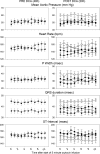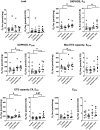Sodium dichloroacetate stimulates cardiac mitochondrial metabolism and improves cardiac conduction in the ovine fetus during labor
- PMID: 34851727
- PMCID: PMC8791792
- DOI: 10.1152/ajpregu.00185.2021
Sodium dichloroacetate stimulates cardiac mitochondrial metabolism and improves cardiac conduction in the ovine fetus during labor
Abstract
Previous studies in our laboratory have suggested that the increase in stillbirth in pregnancies complicated by chronic maternal stress or hypercortisolemia is associated with cardiac dysfunction in late stages of labor and delivery. Transcriptomics analysis of the overly represented differentially expressed genes in the fetal heart of hypercortisolemic ewes indicated involvement of mitochondrial function. Sodium dichloroacetate (DCA) has been used to improve mitochondrial function in several disease states. We hypothesized that administration of DCA to laboring ewes would improve both cardiac mitochondrial activity and cardiac function in their fetuses. Four groups of ewes and their fetuses were studied: control, cortisol-infused (1 g/kg/day from 115 to term; CORT), DCA-treated (over 24 h), and DCA + CORT-treated; oxytocin was delivered starting 48 h before the DCA treatment. DCA significantly decreased cardiac lactate, alanine, and glucose/glucose-6-phosphate and increased acetylcarnitine/isobutyryl-carnitine. DCA increased mitochondrial activity, increasing oxidative phosphorylation (PCI, PCI + II) per tissue weight or per unit of citrate synthase. DCA also decreased the duration of the QRS, attenuating the prolongation of the QRS observed in CORT fetuses. The effect to reduce QRS duration with DCA treatment correlated with increased glycerophosphocholine and serine and decreased phosphorylcholine after DCA treatment. There were negative correlations of acetylcarnitine/isobutyryl-carnitine to both heart rate (HR) and mean arterial pressure (MAP). These results suggest that improvements in mitochondrial respiration with DCA produced changes in the cardiac lipid metabolism that favor improved conduction in the heart. DCA may therefore be an effective treatment of fetal cardiac metabolic disturbances in labor that can contribute to impairments of fetal cardiac conduction.
Keywords: ECG; cortisol; fetus; labor; stress.
Conflict of interest statement
No conflicts of interest, financial or otherwise, are declared by the authors.
Figures





Similar articles
-
Chronic maternal hypercortisolemia in late gestation alters fetal cardiac function at birth.Am J Physiol Regul Integr Comp Physiol. 2018 Mar 1;314(3):R342-R352. doi: 10.1152/ajpregu.00296.2017. Epub 2017 Nov 1. Am J Physiol Regul Integr Comp Physiol. 2018. PMID: 29092858 Free PMC article.
-
Pharmacokinetic and Biochemical Profiling of Sodium Dichloroacetate in Pregnant Ewes and Fetuses.Drug Metab Dispos. 2020 Jun;49(6):451-458. doi: 10.1124/dmd.120.000330. Epub 2021 Apr 2. Drug Metab Dispos. 2020. PMID: 33811107 Free PMC article.
-
Chronic maternal cortisol excess during late gestation leads to metabolic alterations in the newborn heart.Am J Physiol Endocrinol Metab. 2019 Mar 1;316(3):E546-E556. doi: 10.1152/ajpendo.00386.2018. Epub 2019 Jan 8. Am J Physiol Endocrinol Metab. 2019. PMID: 30620638 Free PMC article.
-
The pharmacology of dichloroacetate.Metabolism. 1989 Nov;38(11):1124-44. doi: 10.1016/0026-0495(89)90051-6. Metabolism. 1989. PMID: 2554095 Review.
-
Effects of various doses of sodium dichloroacetate on hyperlactatemia in fed ischemic rats.Ann Emerg Med. 1989 Nov;18(11):1162-71. doi: 10.1016/s0196-0644(89)80053-8. Ann Emerg Med. 1989. PMID: 2683899 Review.
Cited by
-
Chronic maternal hypercortisolemia models stress-induced adverse birth outcome and altered cardiac function in newborn lambs.Am J Physiol Regul Integr Comp Physiol. 2022 Aug 1;323(2):R193-R203. doi: 10.1152/ajpregu.00041.2022. Epub 2022 Jun 7. Am J Physiol Regul Integr Comp Physiol. 2022. PMID: 35670476 Free PMC article.
References
-
- Rog-Zielinska EA, Thomson A, Kenyon CJ, Brownstein DG, Moran CM, Szumska D, Michailidou Z, Richardson J, Owen E, Watt A, Morrison H, Forrester LM, Bhattacharya S, Holmes MC, Chapman KE. Glucocorticoid receptor is required for foetal heart maturation. Hum Mol Genet 22: 3269–3282, 2013. doi: 10.1093/hmg/ddt182. - DOI - PubMed
Publication types
MeSH terms
Substances
Grants and funding
LinkOut - more resources
Full Text Sources
Medical
Miscellaneous

